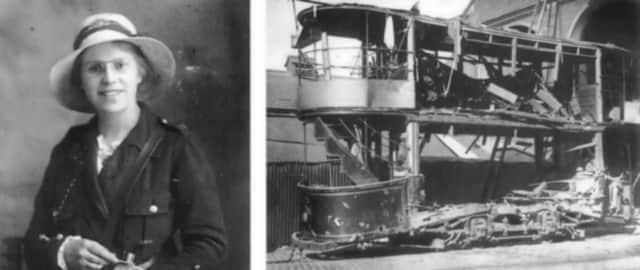Tributes to Sunderland victims of wartime Zeppelin attack to be unveiled


More than 20 people died, and over 100 were wounded, after 32 explosives and 22 incendiaries dropped across the town on April 1, 1916.
Among those to perish were tram inspector Thomas Shepherd and siblings Henry and Gertrude Patrick.
Advertisement
Hide AdAdvertisement
Hide AdNow the tragedy is to be marked with the unveiling of a memorial bench at Wheatsheaf Green and artwork at Monkwearmouth Station Museum.
“War came to Sunderland in a terrifying manner,” said John Kelly, the council’s portfolio holder for public health, wellness and culture.
“The event on April 1 marks this tragic time and reminds us of the Home Front, where civilians were also caught up in conflict.”
The silent invasion by Zeppelin L11 not only brought death to Wearside, but also damaged roads, flattened houses and destroyed a tram.
Advertisement
Hide AdAdvertisement
Hide AdMillfield and Deptford were first to be on the receiving end of L11’s payload – before it turned its attentions on Monkwearmouth.
Bombs dropped on Thomas Street School, Victor Street and St Benet’s Church at Whitburn Street, as well as the Goods Yard and station.
Tram Number 10, which had been pulled up in North Bridge Street following warning of raid, was hit too, killing Inspector Thomas Shepherd.
Reports by the German Admiralty claimed the “violent explosions and the outbreak of fires clearly indicated the good effect of our attacks.”
Advertisement
Hide AdAdvertisement
Hide AdBut the Echo, however –in line with strict wartime censorship – reported that the “attack caused no panic, just feelings of indignation”.
An inquest into the deaths of 18 victims was held on April 4, including those of 16-year-old Henry Patrick and his sister Gertrude, 18.
The pair were believed to have been seeking safety when the bombs dropped but died from shrapnel, shell and flying glass wounds.
One woman who survived the terrible raid was Margaret Holmes, a conductress blasted from Tram No. 10 when bombs dropped on Monkwearmouth.
Advertisement
Hide AdAdvertisement
Hide AdShe later recalled: “A bomb fell clean through my tram. I was blown right out and I came to rest in water coming from a burst main.”
Margaret suffered severe injuries to her right leg in the blast, and spent months in hospital before returning to work with the Tramways.
“Aunt Maggie had to leave the trams and work in the office. She was in a leg brace for the rest of her life,” said relative Malcolm Holmes.
“She was a lovely lady, who used to come round to our house when I was little.
“But she never really talked much about what happened.”
Advertisement
Hide AdAdvertisement
Hide AdThe Zeppelin raid remained forever in the memory of Wearside woman Harriet O’Leary, however, who recalled the incident for the Echo in 2005.
“That day was lovely and sunny,” she said. “I’d been to the pictures with my grandmother, and we got fish and chips before going home.”
Home for Harriet and her gran was a cottage in Packard Street, Millfield.
“Both retired to bed several hours before the Zeppelin attacked.
Advertisement
Hide AdAdvertisement
Hide Ad“I can remember all the ceiling falling on top of us,” recalled Harriet.
“To protect me, my grandmother covered me up with bedclothes.
“If she hadn’t gone to bed when she did, she would have been killed. The fireplace had fallen on her chair where she had been knitting.
“We had a canary that used to wake us by singing. It was blown across the room and, though it never sang again, it lived another 11 years.”
Advertisement
Hide AdAdvertisement
Hide AdThe raid would be one of the first times, but certainly not the last, that Wearside was attacked during World War One and Two.
Indeed, Sunderland became one of the eight most-bombed towns in Britain during Word War Two – with hundreds killed or injured.
“I believe it is a good idea to commemorate the Zeppelin raid,” said Malcolm Holmes, owner of ABP Property Consultants. “I’m sure my aunt would have thought so.”
l The memorial will be unveiled at 10.30am on Wheatsheaf Green on April 1.